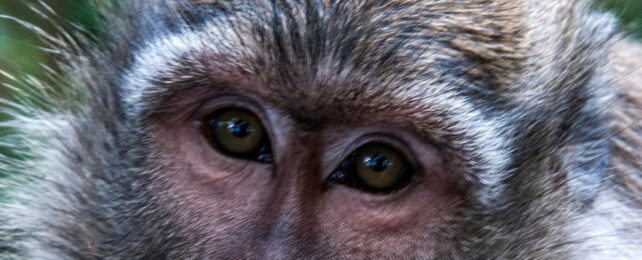Primates can detect faces out of the corner of their eyes with incredible speed via a newly discovered brain circuit.
Brain scans suggest when rhesus macaque monkeys (Macaca mulatta) catch something in their peripheral vision, the blurry mess is categorized as a face or an object in under 40 milliseconds, even before the animals turn their gaze to get a proper, discriminating look.
The rapid transfer of information occurs through an evolutionarily ancient 'shortcut', which travels from the eyes to an early part of the visual cortex and onto a part of the midbrain, known as the superior colliculus. The circuit is distinct from the part of the brain that recognizes familiar faces, which instead involves a longer circuit that flows through 'younger' parts of the primate visual cortex.
Human brains, for instance, can recognize familiar faces in the center of their vision about 380 milliseconds after they are first presented, which is about 80 milliseconds faster than they're able to detect an unfamiliar face.
The shorter circuit takes even less time, but can only detect a face-like thing floating in the periphery.
While researchers are not sure if neurons in the superior colliculus play the same role in humans as they do in macaques, they are known to allow young human children to follow faces and react to emotional stimuli.
"This newly discovered circuit explains how we're able to quickly detect and look at faces, even if they first show up in the peripheral visual field where visual acuity is poor," explains neuroscientist Richard Krauzlis from the US National Institutes of Health (NIH).
"This circuit could be what spotlights faces to help the brain learn to recognize individuals and understand complex facial expressions, helping us acquire important social interaction skills."
In experiments, researchers at the NIH scanned the brains of two macaques to see which neurons activated when the animals were shown images of monkey faces, human faces, bodies, hands, fruits or vegetables, or human-made objects.
The images were placed just outside of a monkey's central visual field, so they couldn't be seen clearly through known face-recognition brain circuits.
Ultimately, the team at NIH counted 140 neurons of the superior colliculus that responded most strongly to the faces of other monkeys in the periphery.
When the results were pooled, the team found that both monkeys could discriminate between faces and non-faces just 30 milliseconds after an image was shown. By 50 milliseconds, that discrimination had reached 80 percent accuracy, and at 90 milliseconds, accuracy peaked at 92 percent.
By contrast, the superior colliculus of both monkeys discriminated between animate and inanimate objects with only 75 percent accuracy, roughly 65 milliseconds after the image was shown.
The slower response to objects suggests that higher-order cortical areas are needed to make conscious sense of what the eyes are seeing. Features that look like they belong to a face, on the other hand, bypass that longer route and immediately trigger neurons in the midbrain.
The findings help explain why newborns fixate on faces despite not yet having developed 'face patches' in their visual cortex – collections of neurons dedicated to detecting faces – or unique patterns of neurons that encode information for each and every familiar face.
The newly discovered circuit also helps explain why some primates orient themselves toward other faces at a speed too quick to be explained by their patch neurons, which undertake a "slower but finer discrimination of faces."
Researchers at the NIH now want to investigate if this same face-preference circuit exists in humans.
"We believe this face-preference circuit may actually drive the development of the brain's more advanced facial recognition processes," says Krauzlis.
"If so, deficits in this face preference in the superior colliculus might play a role in autism."
The study was published in Neuron.
